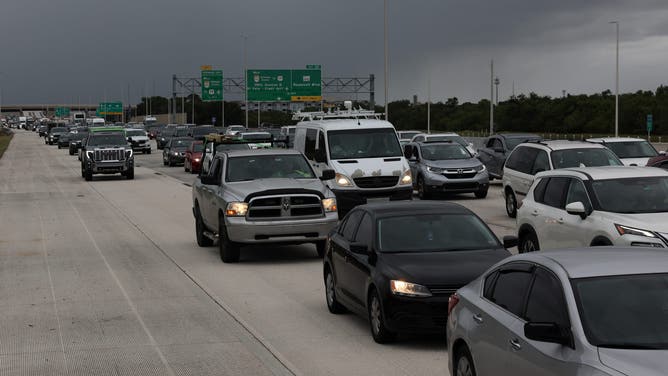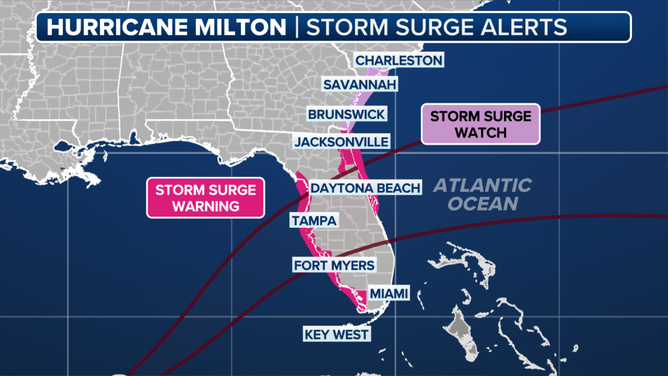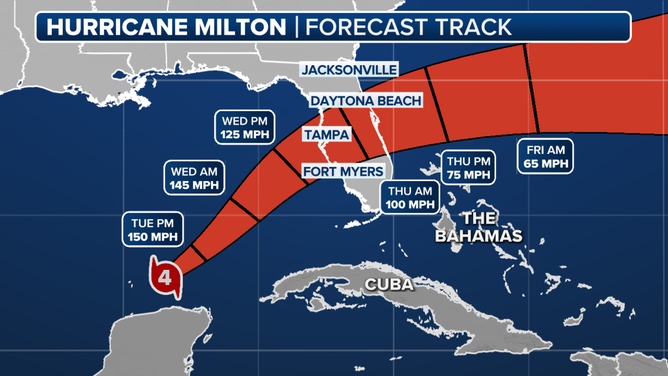Hurricane Milton regains Category 5 intensity as Florida residents prepare for life-threatening impacts
Hurricane Warnings now cover both the east and west coasts of Florida as Hurricane Milton approaches. The National Hurricane Center warns Milton poses an "extremely serious threat" to Florida with life-threatening impacts.
Hurricane Milton regains Category 5 status before expected Thursday landfall
Hurricane Milton is once again a Category 5 cyclone and is expected to remain a powerful hurricane through landfall on Thursday.
This story is now archived. We are updating the latest on Hurricane Milton at this link.
TAMPA – Forecasters say Hurricane Milton has the potential to become one of the most destructive hurricanes on record for west-central Florida, which includes the Tampa area, as millions of residents are in the final hours of preparation.
"It’s worth emphasizing that this is a very serious situation," the National Hurricane Center warned on Tuesday. "Milton has the potential to be one of the most destructive hurricanes on record for west-central Florida."
On Monday, Hurricane Milton underwent rapid intensification and strengthened from a Category 1 hurricane to a near-record-breaking Category 5 hurricane with winds of 180 mph and a minimum central pressure of 897 millibars. Milton has since weakened to a Category 4 hurricane as the storm skirts the coast of Mexico’s Yucatan Peninsula and is expected to remain an "extremely dangerous hurricane" through landfall along Florida’s west coast.
The NHC said the central pressure within Hurricane Milton fell to the second-lowest pressure on record in the Gulf of Mexico and the lowest pressure in the Atlantic Basin since 2005.
In terms of maximum sustained winds, Milton has also become the strongest hurricane in the Atlantic Basin since Hurricane Dorian in 2019 and tied for the fourth-strongest storm since recordkeeping began. Hurricane Allen holds the top spot with maximum sustained winds that reached 190 mph in 1980.
WEST-CENTRAL FLORIDA FACES GREATEST HURRICANE THREAT IN MORE THAN 100 YEARS
Florida residents flee, recovery resources staged
Major airports in Florida shut down as Hurricane Milton's destructive power grows
Floridians are rushing to evacuate from Hurricane Milton, but Orlando's airports are closing their doors, leaving many scrambling for a last-minute escape. FOX 35 Orlando's Amanda McKenzie reports live from Orlando International Airport with the latest.
Hurricane Milton is likely to bring life-threatening impacts to Florida, including a deadly storm surge, destructive hurricane-force winds and flooding rain that has millions of residents finalizing their emergency plans, while countless others are packing up and fleeing the coast and other low-lying areas as state and local officials plead with people to listen to officials and leave if evacuations are ordered.
Florida Gov. Ron DeSantis declared a State of Emergency over the weekend for 51 of the state’s 67 counties, and on Monday, President Joe Biden approved the state’s pre-landfall emergency declaration request, which now authorizes the Department of Homeland Security and the Federal Emergency Management Agency (FEMA) to coordinate all disaster relief efforts and to provide appropriate assistance for required emergency measures.
KNOW YOUR ZONE: FLORIDA EVACUATION MAP SHOWS WHO WILL HAVE TO LEAVE BEFORE A HURRICANE STRIKES
Watch: Police escort trucks filled with debris ahead of Milton's arrival in Florida
FOX Weather Storm Specialist Mike Seidel recorded video of police vehicles escorting trucks filled with storm debris left behind after Hurricane Helene in Madeira Beach, Florida, as preparations coninue ahead of Hurricane Milton.
Local officials began to issue voluntary and mandatory evacuation orders for residents up and down Florida’s Gulf Coast, and traffic has been building on roads and highways since then.
"Of course, we suspended the tolls along evacuation routes and the Florida Department of Transportation has opened roadway shoulders as necessary to facilitate evacuations and ease congestion on both I-4 and I-75," DeSantis said.
On Tuesday, the first evacuations were ordered on Florida's east coast in St. John's County, including St. Augustine Beach. Volusia County also issued evacuation orders for Evacuation Zone A, which includes parts of Daytona Beach, New Smyrna and Ormond Beach.
Both counties will experience a storm surge from the backside of Milton as it barrels across the state.
Shelters have started opening for the thousands of Florida residents who have been told to evacuate for safety, and the state has partnered with Uber to provide residents with free rides to and from shelters for those trying to escape Milton’s eventual wrath.
To the north, Atlanta Motor Speedway said it was opening its campgrounds free of charge to evacuated Florida residents.
The National Weather Service office in Tampa is warning of catastrophic damage and some homes may be uninhabitable "for weeks or months."
"Structural damage to sturdy buildings, some with complete roof and wall failures," the NWS warned. "Complete destruction of mobile homes. Damage greatly accentuated by large airborne projectiles."
Schools and universities across the region have been closed, and resources have been staged to assist in recovery efforts once the storm passes and it’s safe to do so.

ST. PETERSBURG, FLORIDA - OCTOBER 07: Traffic is heavy as thousands evacuate ahead of Hurricane Milton as it churns in the Gulf of Mexico on October 07, 2024, in St. Petersburg, Florida. Milton, which comes on heels of the destructive Hurricane Helene, has strengthened to a Category 5 storm as it approaches Florida’s Gulf Coast near St. Petersburg and Tampa, where it is projected to make landfall Wednesday. (Photo by Spencer Platt/Getty Images)
(Getty Images)
Travel is also expected to be significantly impacted by Hurricane Milton, with airports across the region announcing they will cease operations as Milton approaches.
"We have been dispatching fuel over the past 24 hours as gas stations have run out," DeSantis said on Tuesday. "So, we currently have 268,000 gallons of diesel, 110,000 gallons of gasoline. Those numbers are less than what they were 24 hours ago because we've put a lot in."
DeSantis said an additional 1.2 million gallons of diesel and gas was headed to Florida, and stressed there was no fuel shortage.
Tampa International Airport (TPA) suspended operations on Tuesday morning, while Orlando International Airport (MCO), Orlando Sanford International Airport (SFB) in Sanford, Southwest Florida International Airport (RSW) in Fort Myers, and Melbourne Orlando International Airport (MLB) in Melbourne will close to commercial flights starting on Wednesday.
All theme parks in Central Florida, including Walt Disney World Resort and Universal Orlando, will close on Wednesday ahead of Milton's forecast landfall.
What alerts are in effect because of Hurricane Milton?

Hurricane weather alerts
The first tropical alerts were issued for the U.S. on Monday when Hurricane, Tropical Storm and Storm Surge Watches were issued for Florida’s Gulf Coast.
Those alerts have since expanded and upgraded to warnings as the dangerous situation continues to unfold and Milton gets closer to the Sunshine State.
Hurricane Warnings stretch across the Florida Peninsula from Cedar Key, Tampa, St. Petersburg, Sarasota and Fort Myers on the state’s west coast to Orlando in Central Florida and Daytona Beach and Melbourne on the state’s east coast.
Tropical Storm Warnings have also been expanded to cover all of South Florida, including Miami, Fort Lauderdale, West Palm Beach and the Florida Keys.
Farther north, Tropical Storm Warnings were also issued for Jacksonville, Perry, which was hit hard by Hurricane Helene two weeks ago, and Port St. Joe.

This graphic shows storm surge alerts in Florida due to Hurricane Milton.
(FOX Weather)
Storm Surge Warnings were issued for Florida’s west coast on Monday, and there is the potential for a record storm surge in places like Tampa Bay. The Storm Surge Warnings were expanded to Florida's east coast on Tuesday, and those stretch from north of the Treasure Coast into Southeast Georgia and include the St. Johns River in Northeast Florida.
"If you are in the Storm Surge Warning area, this is an extremely life-threatening situation, and you should evacuate today if ordered by local officials," the NHC warned. "There will likely not be enough time to wait and leave on Wednesday."
HOURS LEFT UNTIL MILTON'S LANDFALL AS FLORIDIANS RACE TO EVACUATE AHEAD OF STORM

This graphic shows the storm surge forecast in Florida due to Hurricane Milton.
(FOX Weather)
A storm surge of up to 15 feet is possible for Tampa Bay, as well as from the Anclote River to Englewood, Florida.
A storm surge of 6-10 feet is possible from Englewood to Bonita Beach, as well as for Charlotte Harbor.
The current storm surge forecast for Tampa Bay is up to 15 feet if the peak surge coincides with high tide. This is notably higher than during Helene, when Tampa Bay saw 7-8 feet of storm surge.
What's the latest with Hurricane Milton?

(FOX Weather)
Hurricane Milton is located about 500 miles southwest of Tampa, Florida, and has maximum sustained winds of 165 mph, making it a strong Category 5 hurricane on the Saffir-Simpson Hurricane Wind Scale.
The NHC says Hurricane Milton's wind field is expected to grow as the storm approaches the Sunshine State.
"The official forecast shows the hurricane and tropical-storm-force winds roughly doubling in size by the time it makes landfall," the NHC said. "Therefore, damaging winds, life-threatening storm surge, and heavy rainfall will extend well outside the forecast cone."
What is the forecast for Hurricane Milton?

This graphic shows the forecast track of Hurricane Milton.
(FOX Weather)
The National Hurricane Center says Hurricane Milton is moving off to the east-northeast, and a turn to the northeast with an increase in forward speed is expected on Tuesday and continue through Thursday.
On that forecast track, the NHC says the center of Hurricane Milton will move across the eastern Gulf of Mexico and approach the west-central coast of Florida through Wednesday.
The center is likely to make landfall along the west-central coast of Florida on Wednesday night, and then move east-northeastward across central Florida through Thursday.

The power outage forecast from Hurricane Milton.
(FOX Weather)







